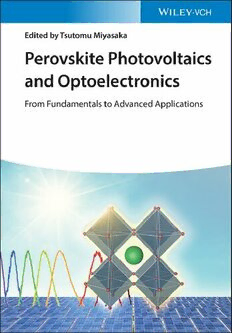Table Of ContentPerovskitePhotovoltaicsandOptoelectronics
Perovskite Photovoltaics and Optoelectronics
From Fundamentals to Advanced Applications
Edited by
Tsutomu Miyasaka
Editor AllbookspublishedbyWILEY-VCHarecarefully
produced.Nevertheless,authors,editors,and
Prof.TsutomuMiyasaka publisherdonotwarranttheinformation
ToinUniversityofYokohama containedinthesebooks,includingthisbook,
GraduateSchoolofEngineering tobefreeoferrors.Readersareadvisedtokeep
1614Kurogane-cho inmindthatstatements,data,illustrations,
Aoba-ku proceduraldetailsorotheritemsmay
225-8503Yokohama inadvertentlybeinaccurate.
Japan
LibraryofCongressCardNo.:appliedfor
CoverImages:©sutadimages/
Shutterstock,©ESBProfessional/ BritishLibraryCataloguing-in-PublicationData
Shutterstock,spectrum–Tsutomu Acataloguerecordforthisbookisavailable
Miyasaka fromtheBritishLibrary.
Bibliographicinformationpublishedby
theDeutscheNationalbibliothek
TheDeutscheNationalbibliothekliststhis
publicationintheDeutscheNationalbiblio-
grafie;detailedbibliographicdataareavailable
ontheInternetat<http://dnb.d-nb.de>.
©2022WILEY-VCHGmbH,Boschstr.12,
69469Weinheim,Germany
Allrightsreserved(includingthoseof
translationintootherlanguages).Nopartof
thisbookmaybereproducedinanyform–by
photoprinting,microfilm,oranyothermeans–
nortransmittedortranslatedintoamachine
languagewithoutwrittenpermissionfromthe
publishers.Registerednames,trademarks,etc.
usedinthisbook,evenwhennotspecifically
markedassuch,arenottobeconsidered
unprotectedbylaw.
PrintISBN: 978-3-527-34748-3
ePDFISBN: 978-3-527-82637-7
ePubISBN: 978-3-527-82638-4
oBookISBN: 978-3-527-82639-1
Typesetting Straive,Chennai,India
Printedonacid-freepaper
10 9 8 7 6 5 4 3 2 1
v
Contents
Preface xiii
1 ResearchBackgroundandRecentProgressofPerovskite
Photovoltaics 1
TsutomuMiyasakaandAjayK.Jena
1.1 Introduction 1
1.2 HistoryofHalidePerovskitePhotovoltaics 5
1.2.1 DiscoveryofthePerovskiteCrystalForm 5
1.2.2 DiscoveryofMetalHalidePerovskites 6
1.2.3 BeginningofHalidePerovskitePhotovoltaics 8
1.3 SemiconductorPropertiesofOrgano-LeadHalidePerovskites 11
1.4 WorkingPrincipleofPerovskitePhotovoltaics 15
1.5 CompositionalEngineeringfortheHalidePerovskiteAbsorbers 18
1.6 StrategiestoStabilizeHalidePerovskiteSolarCells 20
1.6.1 BridgingtheGapBetweenEfficiencyandStability 20
1.6.2 EnhancingIntrinsicStabilityofHalidePerovskites 22
1.6.3 ExternalandEnvironmentalStability 24
1.7 ProgressofAllinorganicandLead-FreePerovskites 34
1.8 EnhancingEfficiencyofLow-CostTandemSolarCells 39
1.9 SpaceApplicationsofthePerovskiteSolarCells 42
1.10 ConclusionandPerspectives 44
References 45
2 HalidePerovskiteMaterials,StructuralDimensionality,and
Synthesis 61
YukoTakeokaandDavidB.Mitzi
2.1 Three-DimensionalandLow-DimensionalSemiconductors:
Organic-InorganicPerovskites 61
2.2 Perovskite-TypeMetalHalideCompounds 62
2.3 PreparationofTwo-toThree-DimensionalLeadHalide-Based
PerovskiteCompounds 66
2.3.1 Spin-CoatingMethodforSynthesis 67
2.3.2 VacuumEvaporationMethod 70
vi Contents
2.3.3 Two-StepDepositionMethod 72
2.3.4 Self-IntercalationMethod 73
2.3.5 Layer-by-LayerSelf-AssemblyMethod 74
2.3.6 Langmuir–BlodgettMethod 75
2.4 Conclusion 75
References 76
3 MicrostructuresandGrainBoundariesofHalidePerovskite
ThinFilms 81
YuanyuanZhouandNitinP.Padture
3.1 Introduction 81
3.2 MicrostructureCharacteristics 82
3.2.1 TheNatureofGrainBoundaries(GBs) 82
3.2.2 GrainSizeandDistribution 86
3.2.3 CrystallographicTexture 87
3.3 MicrostructuralEvolutioninHPThinFilms 88
3.3.1 GenesisofMicrostructure 88
3.3.2 GrainGrowth 89
3.4 InfluenceofMicrostructuresandGBsonPerformanceandStability 92
3.4.1 GrainSizeEffects 92
3.4.2 EffectsoftheNatureofGBs 95
3.4.3 CrystallographicTextureEffects 98
3.5 Outlook 99
Acknowledgments 101
References 101
4 DefectPropertiesofHalidePerovskitesforPhotovoltaic
Applications 107
ZewenXiaoandYanfaYan
4.1 Introduction 107
4.2 DefectPropertiesofABX HalidePerovskites 108
3
4.2.1 Pb-BasedHalidePerovskites 108
4.2.1.1 PointDefects 108
4.2.1.2 IdealGrainBoundaries 111
4.2.1.3 IdealSurfaces 113
4.2.1.4 SurfacesandBoundariesinRealThinFilms 114
4.2.2 Sn-BasedHalidePerovskites 115
4.2.3 Ge-BasedHalidePerovskites 116
4.3 DefectPropertiesofHalidePerovskitesBeyondABX 117
3
4.3.1 A BX HalidePerovskiteDerivatives 117
2 6
4.3.2 A B X LayeredHalidePerovskites 118
3 2 9
4.3.3 A B(I)B(III)X HalideDoublePerovskites 120
2 6
4.4 Conclusion 123
References 123
Contents vii
5 PhysicsofPerovskiteSolarCells:Efficiency,Open-Circuit
Voltage,andRecombination 127
WolfgangTress
5.1 Theory 127
5.1.1 Power-ConversionEfficiencyofaSolarCell 127
5.1.2 TheIdealSolarCell:Shockley–QueisserLimit 129
5.1.3 RadiativeLimit,Reciprocity,andDetailedBalance 132
5.1.4 Non-radiativeRecombinationandRoleofContacts 135
5.2 DeterminingEfficiencyandCharacterizingRecombination 137
5.2.1 TheCurrentDensity–Voltage(J–V)Curve 137
5.2.2 DeterminationoftheBandgapandthe“VoltageDeficit” 138
5.2.3 Electroluminescence 142
5.2.4 Photoluminescence 142
5.2.5 TransientPhotoluminescence 144
5.2.6 ElectrochemicalImpedanceSpectroscopy 146
5.2.7 TransientPhotovoltageDecayandIMVS 148
5.2.8 TheIdealityFactor 150
5.2.9 SpaceCharge-LimitedCurrents 152
5.3 RecombinationinPerovskiteSolarCells:WhatWeKnow 152
5.3.1 IntrinsicPropertiesofthePerovskiteCrystal 153
5.3.1.1 RelativelyHighAbsorptionandFastRadiativeRecombination 153
5.3.1.2 ShallowDefectsandDefectTolerance 153
5.3.1.3 HighDielectricConstant 154
5.3.1.4 Low-FrequencyLatticePhonons 154
5.3.1.5 FurtherExplanationsforReducedRecombination 155
5.3.2 Impurities 156
5.3.3 GrainBoundaries 156
5.3.4 Interfaces:BetweenAlignmentandPassivation 157
5.3.5 MobileIons 159
5.4 SummaryandOutlook 160
Acknowledgments 161
References 161
6 Ionic/ElectronicConductionandCapacitanceofHalide
PerovskiteMaterials 173
JuanBisquert,GermàGarcia-Belmonte,andAntonioGuerrero
6.1 Introduction 173
6.2 Overview 174
6.3 CarrierTransport 176
6.3.1 GeneralDeterminationofTransportCoefficients,DiffusionCoefficient,
andMobility 176
6.3.2 MixedIonic/ElectronicConductionandTimeConstants 176
6.3.3 MeasurementofIonicConductivitybyGalvanostaticTransient
Method 177
6.3.4 MeasurementofIonicDiffusionbyImpedanceSpectroscopy 179
viii Contents
6.3.5 IonicDriftCausesSuppressionofLuminescence 181
6.4 InterpretationofCapacitancesinSemiconductor
Devices 183
6.4.1 DielectricRelaxation 184
6.4.2 ChemicalCapacitance 184
6.4.3 ElectrodePolarization 185
6.4.4 DepletionCapacitanceattheSchottkyBarrier 185
6.4.5 CapacitanceAssociatedtoDefectLevels 186
6.5 SurfacePolarizationandCapacitancesofMHP 186
6.5.1 GeneralPropertiesoftheCapacitanceofMHP 186
6.5.2 ComplexityofMott–SchottkyAnalysis 191
6.5.3 MeasurementofTrapDensity 192
6.6 ImpedanceSpectroscopyandtheEquivalentCircuitModel 194
6.6.1 InterpretationofEquivalentCircuits 194
6.6.2 NegativeCapacitancePhenomena 197
6.6.3 ApplicationofISModeltoUnderstandingofMemory
Effects 199
6.7 Intensity-ModulatedPhotocurrentSpectroscopy 200
6.8 DynamicResponseinTimeTransientMethods 203
6.8.1 TimeTransientsofPhotovoltageandCharge–Discharge
Methods 203
6.8.2 Charge–DischargeMethods 205
6.8.3 SignificanceofSurfaceCharginginMHP 205
6.9 Conclusions 207
References 207
7 HysteresisofI–V Performance:ItsOriginandEngineeringfor
Elimination 215
Seul-GiKimandNam-GyuPark
7.1 Introduction 215
7.2 HysteresisinCurrent–VoltagePerformance 216
7.3 MaterialandStructureDesigntoReduceHysteresis 219
7.3.1 GrainBoundaryEngineering 219
7.3.2 InterfacialEngineering 220
7.3.3 DefectEngineering 221
7.4 EffectofAlkaliCationDoping 223
7.4.1 ReductioninHysteresisbyKIDoping:AUniversal
Approach 223
7.4.2 PassivationEffectofExcessKI 225
7.4.3 LocationofPotassiumIoninPerovskite 226
7.4.4 InsituPhotoluminescence(PL)asaTooltoMeasureIonMigration
Kinetics 227
7.5 Summary 229
References 230

